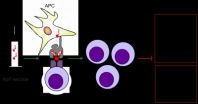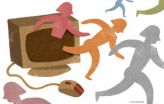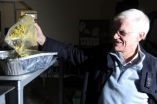The border-monitoring system, known as Helios, consists of laser pulses transmitted through fiber-optic cables buried in the ground that respond to movements on the surface above. A detector at one or both ends of the cable analyzes these responses. Helios is sensitive enough to detect a dog and can discriminate between people, horses and trucks. The system can be set to avoid being triggered by small animals, and can also tell if people are running or walking, or digging, and in which direction.
Zonge, a geophysical engineering company based in Tucson, Ariz., recently installed a Helios test system in the desert near Tucson. The UA's Lowell Institute for Mineral Resources is leading the project to evaluate Helios as a tool for border surveillance, assisted by the UA National Center for Border Security and Immigration.
This is not new technology. Such systems are known as smart sensors and are already used to monitor large engineering works such as dams, pipelines, bridges, and highways for cracks or seismic damage and other unseen strain forces at work deep within structures.
The Helios system consists of fiber-optic cables, lasers and detectors, and is more accurately described as a "distributed acoustic sensor." It relies on the physics phenomenon of "optical backscattering" for its operation, and is made by British company Fotech Solutions.
"It's all a matter of scale," said Scott Urquhart, Zonge president and senior geophysicist, talking about the shift from detecting seismic events to measuring tiny subsurface vibrations caused by desert wildlife, both two- and four-legged.
"When very small vibrations hit the fiber-optic cables, the cables are slightly distorted," Urquhart said. "This distortion creates a unique signature change in the laser pulses, which can be detected by the Helios unit."
Urquhart said the Zonge team buried several types of cable at the desert test location. "Each had different properties in terms of flexibility or type of shielding," he said. "The advantage of a Kevlar cable, of course, versus a steel cable, is that the Kevlar cable cannot be found with a metal detector."
Nor does digging up the cable and cutting it clean through stop the system working, provided a Helios unit is connected to both ends of the cable, Urquhart said. "We can detect people digging up the cable, and even if they cut it the signal doesn't stop flowing from the cut back to the Helios unit," he said.
The resolution of the cable can be set to one-meter intervals, which means that the location of a cut cable, or people, or vehicles, can be pinpointed instantly to within one meter along a section of cable up to 50 kilometers long.
Moe Momayez, associate professor of mining and geological engineering at the UA Lowell Institute for Mineral Resources, is co-author of a report detailing the recent Helios tests. "We can install cables up to 50 kilometers in length with only one Helios detector," he said. "Because the 50-nanosecond laser pulses travel at the speed of light, we can detect any event virtually instantaneously and deploy the appropriate resources to that location."
These 50-kilometer cable lengths, each with a Helios detector, can be strung together indefinitely to cover vast distances. For example, the border between the United States and Mexico is 1,969 miles, or 3,169 kilometers. Although the extreme topography of some border areas would make cable deployment difficult, dividing the border length into 50-kilometer segments equates to approximately 64 cable sections and detector units.
It is envisaged that Helios might be integrated into a larger system that includes mobile surveillance vehicles, such as those currently used by border patrol agents. For this and many other reasons it is too soon to name the cost of monitoring the US-Mexico border, but all on the project agree it would be significantly lower than the ineffective barriers deployed to date, such as steel fences, disconnected grids of sensors, or hi-tech virtual fences.
Momayez's report co-author is Kevin Moffitt, a research scientist at the UA National Center for Border Security and Immigration. They conclude in the report that "with sufficient training, an observer could reasonably differentiate between events triggered by a group of people, cattle, horses, digging tunnels, cars or even 'stealthy' border crossers."
Fotech is already working on automating Helios operation. Once a database of signals has been built up over an extended period of time, advanced pattern-recognition software could be employed to automatically identify events detected by the Helios system. The system would generate an alert if the software determined that a border crosser was being detected.
Zonge and Fotech have signed a 2-year agreement to develop a border security application. The next step, according to the report, is a limited deployment along a stretch of border with a known high volume of border-crossing traffic. Zonge is seeking funding for this extended field trial, results from which would most likely be released at the discretion of the funding agency. Zonge is considering working with a technical partner that could provide large-scale analysis and storage of the volumes of data that the test system will gather.
Because Helios can detect if people are digging in or moving through underground tunnels, the system has great potential for perimeter security – prisons, for example – and mine safety. If such a system were installed in a network of mine shafts and tunnels, a trapped miner could just tap on the rock wall and the system could pinpoint his location to within a couple of feet.
INFORMATION: Background information available to media
Test report: "The Helios System and Border Security: An independent evaluation of the Helios System as applied to Border Security monitoring in Southern Arizona."
Websites
Zonge Engineering: www.zonge.com
Fotech Solutions: www.fotechsolutions.com
UA College of Engineering: www.engineering.arizona.edu
UA National Center for Border Security and Immigration: www.borders.arizona.edu
Lowell Institute of Mineral Resources: www.imr.arizona.edu
Contacts
UA College of Engineering
Steve Delgado, 520-621-2815 or sdelgado@engr.arizona.edu
Pete Brown, 520.621.3754 or pnb@email.arizona.edu
Zonge Engineering
Scott Urquhart: 520.327.5501 zonge@zonge.com
Norm Carlson: 520.327.5501 zonge@zonge.com
Media Notes
Photos, system screen grabs and other graphics related to the Helios system report are available to media by contacting UA College of Engineering Communications at
communications@engr.arizona.edu or 520.621.3754 or 520.621.2815.
Please credit all photos and graphics as follows:
UA College of Engineering/ www.engineering.arizona.edu




